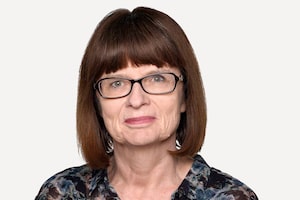This week, a reader complained that a news story shouldn’t have used the “loaded” word “lie” to say the Russians have repeatedly not told the truth through their invasion of Ukraine.
It is loaded, but absolutely true. When a country claims to invade another nation, with a Jewish president, for the purpose of denazification, it’s pretty clear they are lying. It does not help their credibility that they are also vowing to jail people who call it a war. There is no subtlety in the Russian lies and disinformation.
Openly describing a lie is necessary in the battle against disinformation, but it’s not the only tool.
The best disinfectant to the lies of war is the work of journalists, especially on the ground.
The Globe and Mail has had as many as eight reporters in Ukraine or Europe this month. As well, it uses trusted wire services, which also have reporters on the ground, including the Associated Press.
Mark MacKinnon, The Globe’s senior international correspondent and a former Moscow bureau chief, has covered Russia’s war in Chechnya and the Orange Revolution in Ukraine and has been in Ukraine many times, including in the weeks leading up to war, and then in various cities for the early period of the war.
He said that being on the ground is key, allowing reporters to verify information directly.
“For instance, a week before the war started I was in Stanytsia Luhanska, in the Donbas region, where a kindergarten was hit by shelling on Feb. 17,” he wrote to me in an e-mail. “The Russians accused Ukrainian forces of shelling the building themselves, to win international sympathy. But just by standing and looking at the impact marks (one in the wall of the school, the other in the playground outside), I could see for myself that the direction of fire was from the south, and the areas of Luhansk controlled by Moscow’s proxy forces.
“I’ve also seen with my own eyes that civilian buildings such as apartment blocks in the suburbs of Kyiv have been hit by Russian air strikes and artillery, putting to rest the idea that they were only hitting military targets (another key part of the Kremlin’s narrative to its own population).”
Verifying the truth can be a challenge when it comes to photos and videos. The Globe is part of a worldwide group called Content Authenticity Initiative, which aims to combat visual fiction.
Patrick Dell, The Globe’s senior visuals editor, said Globe photo editors conduct their own verification to confirm the facts about locations.
“That includes looking at photos of the same scene, searching for other angles, studying satellite images and using Google Street View. Monitoring footage shared on platforms like Twitter, Telegram and Reddit gives a sense of what is fresh and what is a few days old so we don’t recycle visuals,” he told me.
“We don’t repeat claims shared with videos on social media we can’t confirm from other sources.”
He gave the example of one clip that showed the aftermath of an attack on a Ukrainian ambulance. Because Globe U.S. correspondent Nathan VanderKlippe, who has been reporting from Europe during the war, was there, he was able to verify that the person being treated near the destroyed vehicle in the video was the same person he interviewed for a story.
“It showed the value and importance of having journalists in the field,” said Mr. Dell.
Another technique to expose lies is using a “truth sandwich,” in which you first share the truth of what is happening, then describe the lie, returning finally to the truth.
While you need to know what Russia is saying, care must be taken not to amplify their statements and not just repeat what is untrue.
UNESCO gives some good pointers on how to deal with disinformation.
It notes that we are seeing “the weaponisation of information on an unprecedented scale. Powerful new technology makes the manipulation and fabrication of content simple, and social networks dramatically amplify falsehoods peddled by States, populist politicians, and dishonest corporate entities, as they are shared by uncritical publics.”
During this war, the differences between dictatorships and democracies are clear, and one key difference is a free press working to report the truth.
An example of this in Ukraine have been the two Associated Press reporters who were the last international journalists on the ground in the dangerous war zone of Mariupol.
The Globe published a story by Mstyslav Chernov, a video journalist for the Associated Press, about the siege on the city, as documented with photographer Evgeniy Maloletka.
Mr. Chernov wrote: “The Russians were hunting us down. They had a list of names, including ours, and they were closing in.”
He and Ms. Maloletka were reporting from inside a hospital when “gunmen began stalking the corridors. Surgeons gave us white scrubs to wear as camouflage.” At dawn the next day, soldiers burst in, asking: “Where are the journalists? … We’re here to get you out.”
Mr. Chernov said they learned “from a policeman why the Ukrainians had risked the lives of soldiers to extract us from the hospital. ‘If they catch you, they will get you on camera and they will make you say that everything you filmed is a lie,’ he said. All your efforts and everything you have done in Mariupol will be in vain.”
Our Morning Update and Evening Update newsletters are written by Globe editors, giving you a concise summary of the day’s most important headlines. Sign up today.
 Sylvia Stead
Sylvia Stead